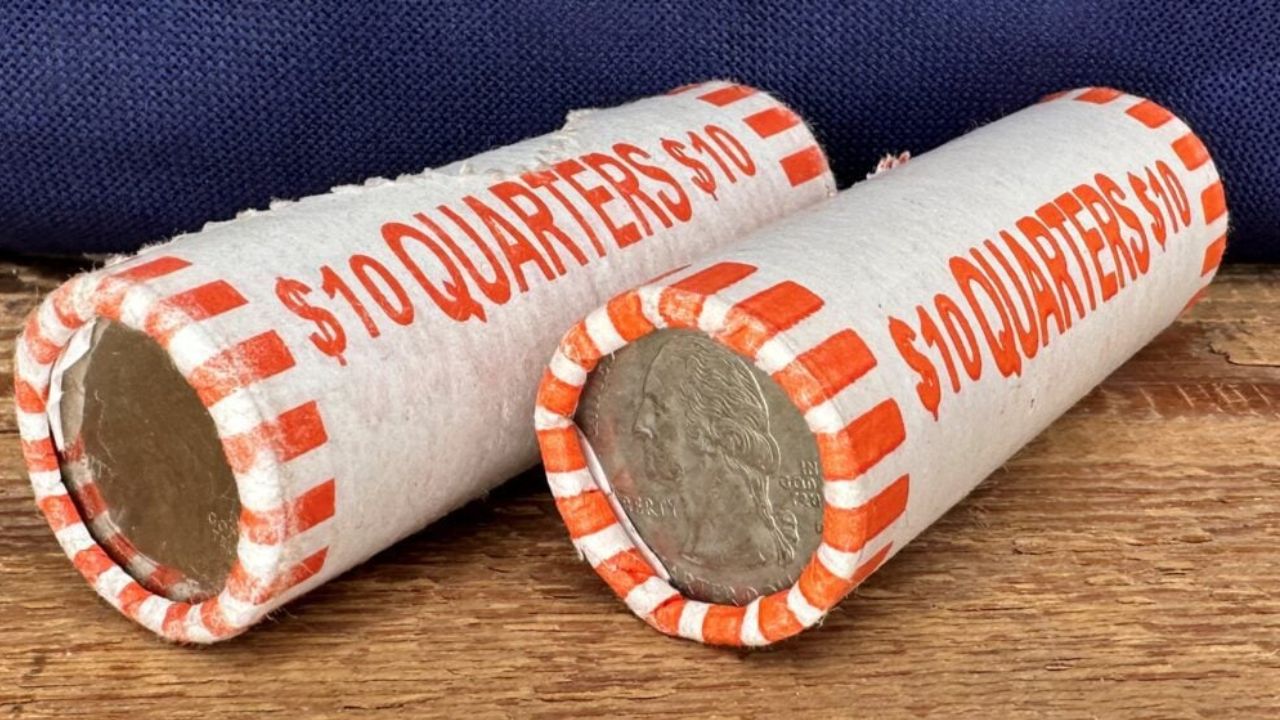If you’ve ever wondered, “How much is a roll of quarters?” as coin enthusiasts, you’re in the right place. In this detailed guide, we’ll delve into the factors that determine the value of a roll of quarters, uncovering the refinement of coin appraisal and sharing valuable insights for both seasoned collectors and those new to the hobby.
Table of contents
- What are Coin Rolls?
- The Basics of Quarters
- Factors Influencing Value
- How Much is a Roll of Quarters: Calculating Coin Value
- Where to Get Coin Rolls?
- What is the Easiest Way to Roll Coins?
- Where to Get Paper Wrappers to Roll Your Coins?
- How Many Quarters in a $10 Roll?
- How Many Quarters in a Bank Roll?
- FAQs
- Conclusion
- References
- Recommendations
What are Coin Rolls?
Coin rolls are a fascinating aspect of numismatics, attracting both seasoned collectors and newcomers to the hobby. In this comprehensive guide, we’ll explore everything about coin rolls, from where to find them to the essential details of rolling coins efficiently.
Join us on this journey as we unravel the mysteries behind $10 rolls, bank rolls, and more. However, before we move further, let’s understand the basics of Quarters.
You can read this: How Many Quarters Are in a Roll?
The Basics of Quarters
Understanding the Composition of a Roll
Have you ever pondered on what makes up a roll of quarters? Exploring this fundamental aspect sets the stage for comprehending their value. A roll typically consists of 40 quarters, each having its unique characteristics and historical significance.
Therefore, from the classic Washington quarter to commemorative editions, every coin contributes to the overall value of the roll.
How Much is a Roll of Quarters Worth?
The million-dollar question — or perhaps, quarters worth! The value of a roll depends on various factors, such as rarity, condition, and historical significance. We’ll unravel the mystery behind these elements, guiding you through the intricacies of coin valuation.
Factors Influencing Value
Rarity: The Golden Ticket
In the world of coin collecting, rarity reigns supreme. Rare quarters can significantly boost the value of a roll. Let’s explore the rare gems that collectors covet and the impact they have on the overall worth of your coin collection.
Condition Matters
The condition of your quarters plays a pivotal role in determining their value. Whether it’s a pristine, uncirculated coin or one that has weathered the hands of time, we’ll discuss how condition affects the market value and appeal of your collection
Historical Significance
Beyond metal and design, the historical background of a quarter can contribute to its allure. From coins minted during significant events to those featuring unique designs, we’ll delve into the historical context that adds a layer of fascination to your collection.
Also, read this: Where Can I Cash in Coins For Free (Or Cheap)
How Much is a Roll of Quarters: Calculating Coin Value
The value of a roll of quarters depends on the face value of the coins and the number of quarters in the roll. In the United States, a standard roll of quarters contains 40 coins. Quarters have a face value of $0.25 each.
To calculate the value of a roll of quarters, you can use the following formula:
Value of a roll of quarters = Number of quarters in the roll × Face value of each quarter
For a standard roll of 40 quarters:
{Value of a roll of quarters} = 40 × $0.25 = $10.00
So, a roll of quarters is worth $10.00 in total. Keep in mind that if the quarters are rare or collectible, they may have a higher value to collectors, but the face value is still $10.00.
Where to Get Coin Rolls?
Navigating the world of coin rolls starts with knowing where to find them. Whether you’re a collector or someone looking to roll spare change, these sources are gold mines:
- Local Banks: Your neighborhood banks are excellent places to inquire about coin rolls. Many banks keep a stock of rolled coins, and some may even provide them to customers upon request.
- Credit Unions: Don’t overlook credit unions, as they often have coin rolls available. Establishing a relationship with a credit union might offer you better access to various denominations.
- Coin Shops: Specialized coin shops or numismatic stores are ideal for collectors. They may carry a diverse range of coin rolls, including rare and collectible ones.
- Online Retailers: In the digital age, numerous online platforms cater to coin enthusiasts. Explore reputable websites that specialize in coins to find a wide array of rolls.
You can check this: Why Do Direct Deposits Take So Long? 10 Possible Reasons
What is the Easiest Way to Roll Coins?
Rolling coins might seem like a simple task, but efficiency matters. Here’s a step-by-step guide on the easiest way to roll coins:
- Sort and Organize: Before rolling, categorize your coins by denomination. This ensures a smoother rolling process and saves time.
- Use Quality Wrappers: Invest in durable paper wrappers designed for coins. Sturdy wrappers prevent tears and keep your coins secure.
- Roll with Precision: Place the coins in the center of the wrapper, ensuring an even distribution. Roll tightly, and fold the ends securely to prevent spills.
- Label Clearly: Mark the denomination on the outside of each roll for easy identification. This step is crucial, especially if you plan to deposit them in a bank.
Where to Get Paper Wrappers to Roll Your Coins?
Acquiring the right paper wrappers is essential for secure and organized coin rolling. Here are some places to find them:
- Banks and Credit Unions: Many banks provide free or low-cost coin wrappers to customers. Simply ask a teller for the specific denominations you need.
- Office Supply Stores: Office supply stores often stock coin wrappers in their stationery sections. They offer a variety of options, from simple paper to more durable plastic alternatives.
- Online Retailers: Embrace the convenience of online shopping by exploring e-commerce platforms that specialize in coin accessories. You’ll find a plethora of options to suit your needs.
Also, check this: How Many Grams in a Quarter Pound: Demystifying Weight Conversions
How Many Quarters in a $10 Roll?
Understanding the composition of a $10 roll, especially in quarters, is crucial for both collectors and those dealing with large amounts of change. Here’s the breakdown:
Denomination: A $10 roll of quarters contains 40 quarters. Each quarter represents 25 cents, making the total value $10.
How Many Quarters in a Bank Roll?
When it comes to bank rolls, the quantity of quarters follows a standard pattern:
Denomination: A standard bank roll of quarters consists of 40 quarters. This aligns with the commonly used $10 rolls, making it easy for banks to manage and distribute.
See also: How Many Pints Are in a Quart: Clearing Up Liquid Measurement Confusions
FAQs
Absolutely! Most banks offer coin rolls to customers. Simply visit your local branch and inquire with a teller about the denominations you need.
Yes, some coin rolls contain rare or collectible coins. Consider checking with specialized coin shops or online retailers for unique rolls.
While it’s possible, using paper wrappers ensures a neat and secure roll. It also helps in easy identification and handling.
Many banks provide coin wrappers free of charge to customers. Some may charge a nominal fee, so it’s advisable to inquire beforehand.
Cleaning quarters is generally discouraged, as it may damage the coin’s surface and diminish its value among collectors.
Commemorative quarters, celebrating special events or anniversaries, can indeed be more valuable due to their limited production and unique designs.
Conclusion
Embarking on the journey of coin rolls offers a blend of practicality and fascination. Whether you’re a collector or someone managing spare change, understanding the nuances of obtaining, rolling, and storing coins is essential. With the insights provided here, you’re well-equipped to dive into the world of coin rolls confidently.





